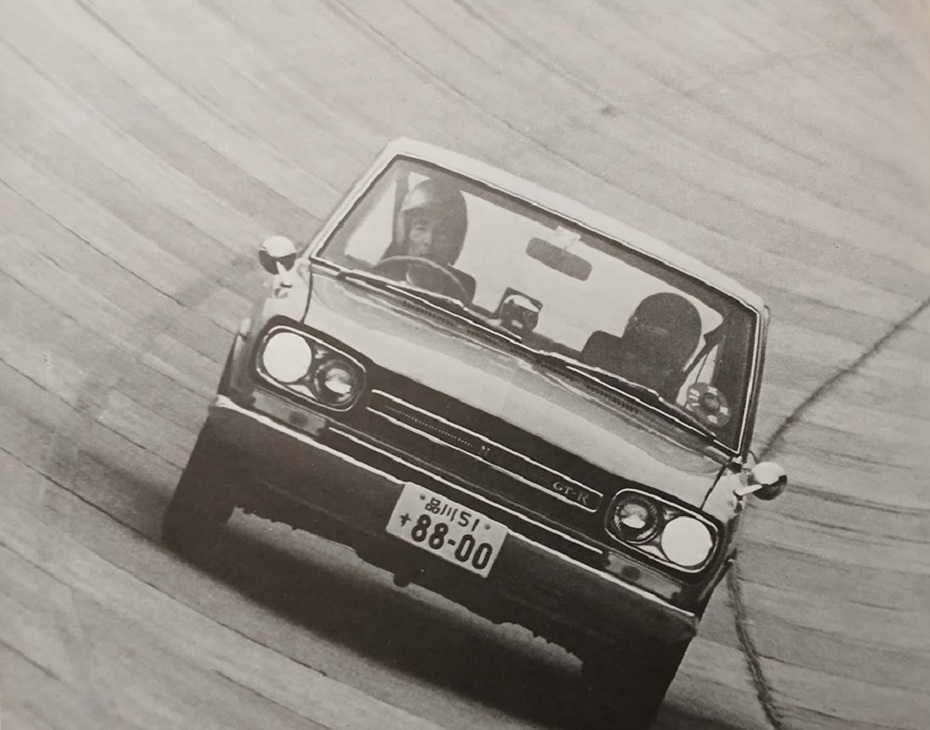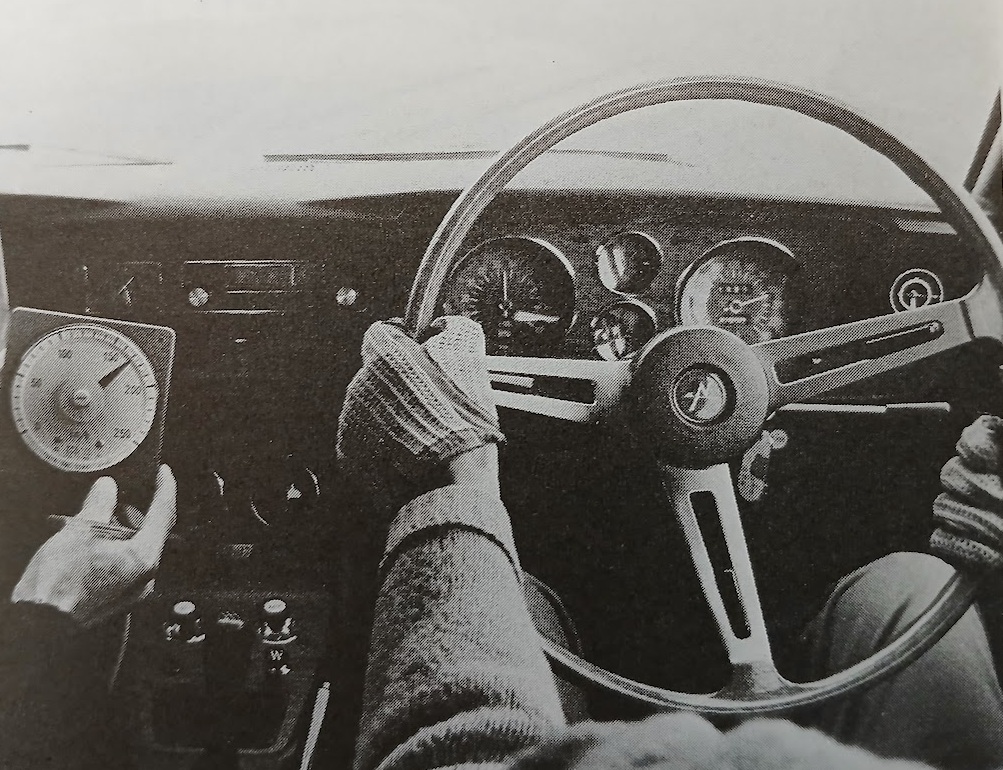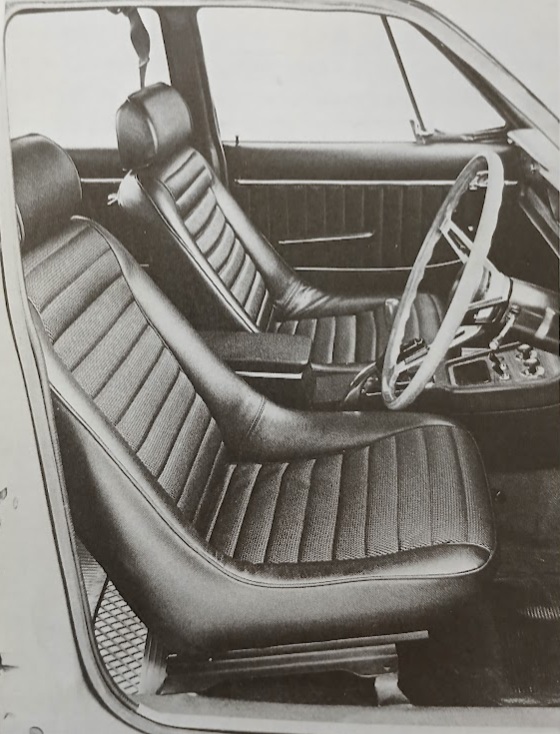Nissan Skyline 2000GT-R (1969)

Publication: Car Graphic
Format: Road Test
Date: May 1969
Author: “C/G Test Group” (uncredited)
Summary: A hot six-cylinder, twin-cam, 24-valve 160ps sports sedan. The engine easily revs up to 8000rpm. Even at low revolutions, it is relatively smooth and strong. The 5-speed gearbox is excellent. The bucket seats provide good support. The suspension is stiff but comfortable. The handling is significantly improved from the 2000GT. The controls are a little heavy, making it difficult to drive around town.
Road testing the Skyline 2000GT-R
Imagine the following: a Group 6 prototype DOHC 4-valve racing engine has been slightly detuned and placed in a seemingly ordinary four-door sedan body, which you are driving nonchalantly around town. A fast-looking two-seater GT approaches from behind, pulling close enough to fill your rearview mirror. You wait, then press the throttle hard, and in that moment the sheep transforms into a wolf, quickly pulling away from the startled GT driver. I’m sure everyone has had a childish fantasy like this at least once. However, the recently released Skyline 2000GT-R makes this dream a reality–if you can afford to spend 1.5 million yen.
The GT-R shares the same body with the existing Skyline 2000GT, but is equipped with a DOHC 160ps/7000rpm engine and a 5-speed gearbox instead of the GT’s SOHC 105ps unit. This engine, called the S20 type, is based on the GR8 type engine of the Nissan R380, which won fame in the Japanese Grand Prix and E-class international records, but has been detuned to be practical for use in the city, and with some compromises to allow productivity of manufacturing. The compression ratio has been changed from 11.0 to 9.5, the camshaft has been revised for more practical valve timing and profile (valve angle from 310° to 250°), and three double-choke Solex carburetors are used instead of the Lucas fuel injection, reducing the output from the GR8 type’s estimated 230ps/8500rpm to 160ps/7000rpm. Nevertheless, it is still a very high-performance unit at 80.4ps/liter.
To put the 2000GT-R in perspective, we think it is best to compare it to its sister car, the 2000GT, and the old 2000GT-B. Where the 2000GT-B (S54B) had a SOHC six-cylinder with 125ps/7000rpm, 17.0kgm/4400rpm, and a vehicle weight of 1095kg, and the 2000GT (GC10) is also SOHC with 105ps/5200rpm, 16.0kgm/3600rpm, and a vehicle weight of 1090kg, the new 2000GT-R (PGC10)’s DOHC six-cylinder has an output of 160ps/7000, a maximum torque of 18.0kgm/5600rpm, and a vehicle weight of 1120kg. The resulting power-to-weight ratios for the S54B, GC10, and PGC10 are 8.8kg/ps, 10.4kg/ps, and 7.0kg/ps, respectively.
As you can see, the horsepower load is much lighter than the old GT-B, and even lighter than a pure GT car like the Toyota 2000GT (7.5kg/ps). The only Japanese car that is better than the GT-R in this respect is the Fairlady 2000 (6.4kg/ps).
At first glance, the interior is not much different from that of the 2000GT (GC10), which shows that the design also prioritizes practicality on the road. Almost the only major difference from the GC10 is the seat, which is a full-fledged bucket seat with a fixed backrest, and a shape and angle that are close to ideal. The driver’s side seat is equipped with a headrest and a three-point seat belt as standard, the steering wheel rim and the shift knob for the 5-speed gearbox have been changed to (real) wood, and the rev counter scale has been extended to 10,000rpm. Other than that, it is the same as the GC10.
However, from the moment the engine starts, you can feel with your whole body that this is no ordinary car. When you first turn the ignition switch, the electromagnetic pump in the trunk makes a busy noise, sending high-octane fuel from the 100-liter tank to the three Mikuni Solex N40PHH carburetors. Like a semi-racing engine with a large valve timing overlap, it doesn’t start up instantly, but it’s by no means temperamental. The moment it starts up is literally explosive. Many C/G readers may have seen an F1 or prototype engine start up in the paddock at a race track, and it’s similar to that feeling, where the starter spins for a long time with a “coo-coo-coo” sound, and just when you think it’s not going to turn over, it starts up with a thunderous roar.
There’s no need to use the choke even on a cold, early morning. Just tapping the throttle a few times is enough. Surprisingly, even after a cold start, the engine idles at a steady 800-900rpm, and once you start driving, it pulls immediately without hesitation. However, if you were the owner of this GT-R, you would never want to drive off without warming it up for at least five minutes, and fully warming the six liters of oil in the crankcase. Even when idling, there is a constant light “buzz” that seems to be due to the timing change, but when you step on the gas, it revs up immediately. The wonderful mechanical noise and exhaust sound reverberate all around the car. In a quiet residential area on a quiet morning, you will probably get complaints if you take your time warming it up properly.
It would be a lie to say that the GT-R is easy to drive around town. First of all, all of the pedals are heavy. The throttle pedal is working against three Solex return springs, so it feels much heavier than even the clutch pedal in a Subaru 1000 (which is unusually light). However, the throttle response is so sensitive that this weight may actually be safer for the average driver to use on the street. The clutch is also extremely heavy, making it a bit of a burden for frequent use around town.
In terms of character, the engine is, to put it simply, a Jekyll-and-Hyde type. Up to about 4000rpm, it feels almost like a normal passenger car, but once it exceeds 5000rpm, it suddenly turns ferocious, and even after passing the redline of 7000rpm, its momentum continues to build, just like a racing engine. It is of course a pure high-speed type in terms of torque characteristics, and it doesn’t have any torque to speak of below 1500rpm. Rather, the sensation of torque is felt suddenly from around 3500rpm, and the most usable rotation range is around 3500 to 6500rpm. So, driving around town at speeds of 60km/h or less is not fun at all.
As mentioned above, the GT-R is equipped with the same Porsche-type servo-synchronized 5-speed gearbox as the Fairlady (the gear case is different because the engine is different). The final drive ratio is 4.44, shorter than the 2000GT’s 3.90. The gear ratios are: 2.957 for first gear, 1.858 for second gear, 1.311 for third gear, 1.000 for fourth gear, and 0.852 for overdrive fifth gear.
This gearbox was described in the Fairlady test report last month. As we said then, it has some very good points. The operation is smooth and light, the throws are moderately short, and the powerful synchros are unbeatable. However, the first gear ratio of 2.957 is a little too tall for this high-speed type engine. Moreover, with the strong grip of the Dunlop GS1 tires, and the limited-slip differential that is standard equipment, getting a clean, quick start off the line takes a little practice. If you do not raise the rotation speed to at least 4000rpm and engage the clutch just right, the moment you release your left foot, the revs will bog down to below 2000rpm and the start will be sluggish. It is impossible to launch with a fierce, wheel-spinning start leaving black tire marks, and even a light 1-liter class passenger car will take the lead for about 10 meters.
Even though the torque curve is peaky, the absolute value of the torque is high, so you can maintain a steady 50km/h in fourth gear and 60km/h (about 2000rpm) in fifth gear if you drive smoothly. However, it goes without saying that accelerating from these speeds is difficult, if not impossible. Therefore, in most urban areas, you can only use up to third gear.
When we got the test car, the odometer was showing barely 1,500km, so it was practically a new car. We were reluctant to conduct high-speed tests on a car that hadn’t been fully run-in yet, but due to time constraints, we had no choice but to bring it to Yatabe in this condition.
The engine was still tight, and the top speed was significantly lower than the catalog value. The GT-R’s nominal top speed is 200km/h, but the test car could not reach more than 180km/h, no matter how much we tried coaxing it to go faster. The C/G test group’s test method is highly reliable, using a fifth-wheel electric speedometer to precisely measure speeds over a 1km straight section and the complete 5.5km circuit. Before the test, we check the accuracy of the fifth wheel. This is done on the 1km section at 60km/h and 120km/h, with an error of less than 1%. In this case, our GT-R averaged 179.6km/h over the 1km straight section and 173.2km/h over the 5.5km lap. The result was the same whether the car was in fifth gear (5600rpm) or fourth gear (6500rpm). In our experience, engines begin to settle in after a mileage of around 5,000km, making the cars they are installed in suddenly feel lighter. Therefore, we would like to make it clear that these figures do not represent the GT-R’s true performance. We would have liked to have tried to reach the top speed again with a GT-R in better condition, but due to time and space constraints (we couldn’t reserve Yatabe on short notice), we had to give up. Incidentally, the speedometer of the test car had an exceptionally large margin of error, indicating 195km/h when the actual speed was not quite 180km/h.
The red zone on the rev counter starts at 7500rpm. But the still-new test car struggled to reach 7500rpm, with the torque dropping sharply from around 6500rpm, so there was virtually no use of the red zone. It seemed that the engine was running hot, and when we applied hard throttle, blue smoke came from the exhaust, especially after a cold start and before it was completely warmed up. We couldn’t measure the oil consumption exactly, but it seemed to be about 400-500km/liter. In any case, it wasn’t excessive. The spark plugs were B-7ES, which covered all the conditions we drove in, and they didn’t burn out. However, looking back, we think perhaps if we had used a colder type plug for the top speed test, the engine may have run a little better, because there was a feeling of the spark cutting out when we pressed the engine to the redline. Coincidentally, the GT-R is the first domestic mass-produced car to use a non-contact full transistor ignition.
The brakes are the same as those on the 2000GT, with 10" Dunlop Sumitomo S16 opposed-piston discs in the front and 9" leading-trailing drums in the rear, but the difference is that the GT-R does not have a vacuum servo (a 4.5" master back, the same as on the 2000GT, is available as an option). This may seem odd at first, but it is because racing drivers dislike the servo’s momentary lag. Therefore, pedal effort is generally higher than that of the 2000GT, and even bringing the car to a gentle stop (about 0.3g), such as at a traffic light, requires a heavy 20kg foot, nearly twice as heavy as in the 2000GT. Effectiveness and response are progressive, with good feel. The braking effect is particularly stable from high speeds, allowing you to drive at high speeds with confidence, but on the other hand, stop-and-go driving in the city can be a bit tiring.
In order to test brake fade, the C/G test group “invented” a test method called 0-100-0. When the car reaches 100km/h after a standing start, 0.5g is applied, and once the car stops, we immediately accelerate up to 100km/h and stop again, and this is repeated ten times. In the case of the GT-R, the pedal pressure for the first stop was 32kg, and on the tenth stop, it was only 34kg, with almost no variation, so there is nothing to criticize in terms of fade resistance. The handbrake is located to the left of the gear lever, and in an emergency stop, this alone can provide a braking force of about 0.3g.
The only safe (and legal) way to test the handling of a car like this is to take it to a closed circuit. We had intended to go to Fuji Speedway, and even arranged for a set of racing tires, but unfortunately, on the day of the test, there was 30cm of snow, the heaviest in March since the weather station began taking measurements, and testing had to be suspended for two days. As a result, we were not able to test the handling to our satisfaction.
As a result, we hesitate to make any definitive statements, but even from our limited experience, we can say with certainty that the handling is much better than that of the 2000GT. The spring constants are 30% higher in the front and 10% higher in the rear than the GT, the front and rear tracks are 44mm wider, the steering ratio is faster, at 18.5:1 (3.3 turns lock to lock) compared to 19.8:1 (3.5 turns lock to lock), and the tires are H-spec (capable of a continuous 205km/h) 6.45H-14-4PR Dunlop GS1s, which we drove at the specified pressure of 2kg/cm² on public roads and 2.3kg/cm² at Yatabe.
The steering force is considerably heavier than the GT, and it requires considerable strength, especially in parking. This is in start contrast to the GT, which is lighter regardless of speed. The straight-line stability on good roads is outstanding, and we could take our hands off the steering wheel without any worries even at 160km/h, but on the other hand, the steering response when going straight is unexpectedly sluggish, and judging from this, plus the heavy steering effort, it is natural to think that there will be severe understeer in corners. It is true that the initial turn-in feels sluggish and stiff, but once the car starts turning, contrary to expectations, it follows your line smoothly. There is very little roll, and the geometry seems to be set to reduce understeer. In tight corners, there is almost no wheelspin due to the limited-slip differential, even when applying full power in in second gear. However, it was surprisingly ineffective in snow and the wheels spun easily, making it difficult to drive.
The GT-R’s ride feels much harder than in the 2000GT. However, due to the long wheelbase, there is no pitching, and it is extremely smooth on good surfaces. It also has strong traction on rough roads, and the suspension never bottoms, although the car does shake up and down quite violently. The front half of the body also flexes a little under these conditions, and the vibration of the steering column in particular was unpleasant. The Dunlop GS1 tires are bias-ply, but their tread is stiff, and even at a pressure of 2kg/cm², considerable steering kickback is transmitted to the driver’s hands.
The interior is exactly the same as the 2000GT’s, except for the good bucket seats, so there is no need to repeat the details here (see C/G, January 1969 for the test of the 2000GT). One thing we noticed about the driving position this time was that the clutch and brake pedals are both positioned too high off the floor, so it gets tiring when your feet are on and off them frequently. It would also be better if they had a shorter stroke. This was especially noticeable because of the heavy pedal pressure.
The frequently-used headlight switch is located far away on the center console, and is difficult to reach from the straight-arm driving position that drivers of this type of car will naturally assume, unless you lean far forward in the seat. As we have said many times before, we hope they will bring back the convenient light switch on the steering column stalk, which was a traditional feature of the Skyline. New additions for the GT-R include a four-way flashing warning light (the switch is under the dash), and a flashlight that shines both red and white (located next to the passenger seat), which will be mandatory for new cars from April 1st onwards.
In conclusion, contrary to our expectations (hopes?), the GT-R turned out to be an effectively detuned high-performance sedan that is sufficiently tractable for practical use around town. However, since it is based on the R380, it will be relatively easy to restore the engine to its full 220ps. Tuning parts for the engine and suspension are already listed in the catalog, each according to its intended purpose, such as rallying or circuit racing, which is very encouraging for drivers who are planning to enter the GT-R in competition. As we have explained, we were unable to test the GT-R’s amazing high-speed performance fully due to the condition of the test car, and we hope to have an opportunity to confirm its true capabilities in the near future.
Postscript: Story Photos





